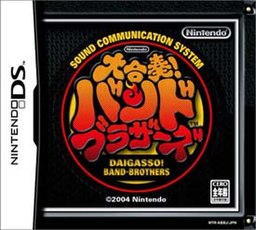Daigasso! Band Brothers
| Daigasso! Band Brothers | |
|---|---|

Japanese box art
|
|
| Developer(s) |
Nintendo R&D2 Nintendo SPD |
| Publisher(s) | Nintendo |
| Composer(s) | Masami Yone Akito Nakatsuka Minako Hamano Masaru Tajima Toshiyuki Sudo |
| Platform(s) | Nintendo DS |
| Release date(s) |
|
| Genre(s) | Music |
| Mode(s) | Single-player, multiplayer |
Daigasso! Band Brothers (大合奏!バンドブラザーズ Daigassō! Bando Burazāzu?, lit. "Grand Ensemble! Band Brothers") is a music video game published and developed by Nintendo for the Nintendo DS handheld game console. It was released in Japan on December 2, 2004 as a launch game for the Nintendo DS. The game features multiple songs, which include classical music, television themes, and video game music. The game is controlled using both the buttons on the DS as well as its touch screen in certain portions. It uses a variety of different instruments, which are combined selectively in order to compose a song. Besides the primary mode, players may play together, each one playing a different instrument in the song. Players may also compose their own songs. It was to be released in the United States as Jam with the Band, but was never released nor formally cancelled. It has a sequel titled Jam with the Band, which was released in Japan in 2008 and in Europe in 2010.
The single-player game of Band Brothers includes 35 normal songs, plus three unlockable songs. These are divided into the categories J-Pop, World, TV (anime/tokusatsu), Classic, and Game (includes a variety of medleys from Nintendo titles such as Mario, Fire Emblem,and Zelda). Each song has a number of parts available for you to play, usually ranging from 6 to 8, and each part will generally be a different instrument, but many songs have more than one part played by the same instrument.
In the Beginner mode, all notes are represented either by a D-Pad icon or a button icon, and any direction or face button respectively will automatically play the correct note. In Amateur mode, each of the eight buttons on the face of the Nintendo DS system correspond to a musical note; there is also a drum set where each button, including the L and R buttons, plays a specific drum or cymbal. As many songs contain fast or difficult parts to play, they are covered in the Beginner and Amateur modes—when the cursor is about to move over them, the lower screen will change to the "touch" command; touching the bottom screen at this time causes the notes underneath the touch screen portion to be played automatically. These do not contribute to the player's score, but prevent high-speed sequences from being forced on the player early on, and activating them helps to keep the rhythm and flow of the song.
...
Wikipedia
